Hard-Knock Life of an Osprey
This is the story of a how a photographer interfaced with a bird banded many years ago, and how the experience helped restore her to health—in body and spirit.

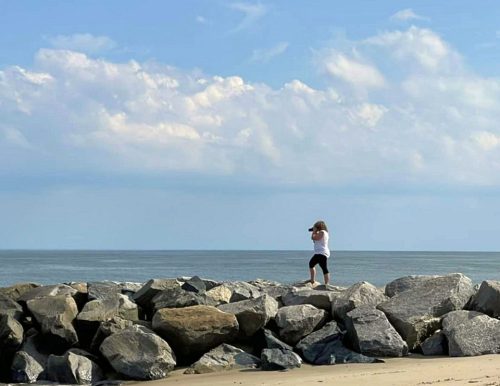
Some stories have a beginning, a middle, and an end. This story ends in the middle, or at least I think so. In January I received an e-mail from biologist Ben Wurst of the Conserve Wildlife Foundation, which monitors New Jersey’s osprey recovery program. He coordinates his organization’s work with our State’s Endangered and Nongame Species Program. Ben had received a message from the U.S. Geological Survey’s Bird Banding Laboratory, its North American Bird Banding Program, that an osprey was sighted this past summer (2023) at Port Mahon, Delaware. A leg band had made this report possible.
My husband and I have been banding osprey since 1985 and occasionally we get a report that one of the chicks we banded has been recovered or sighted. It is especially exciting to get a report on a living bird, since often birds are injured or dead when spotted. However the ever-increasing number of people with good optics, especially long lens cameras, has increased the number of live sightings.
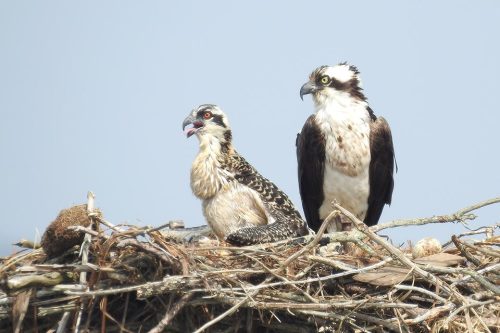
Once I called state wildlife biologist Kathy Clark about a peregrine falcon that I photographed at Brigantine National Wildlife Refuge, only to have her tell me that she had already received numerous calls from other wildlife photographers. She had banded the falcon as a chick and knew it well.
This summer’s bird was sighted and photographed at Port Mahon by Kim Sheaffer. Port Mahon is across the Delaware Bay from Egg Island Wildlife Management Area on Turkey Point, just south of Fortescue, New Jersey. This is about 35 miles south of the Delaware Memorial Bridge in Delaware, adjacent to Bombay Hook National Wildlife Refuge. It is approximately 25 miles from where the bird was reared in Bricksboro (Port Elizabeth), New Jersey in 2006. This is where our osprey’s story began.
My thoughts when I read Ben’s e-mail were, “Wow, a sighting of a live bird!” and then, “Holy smokes, that bird is 17 years old!”
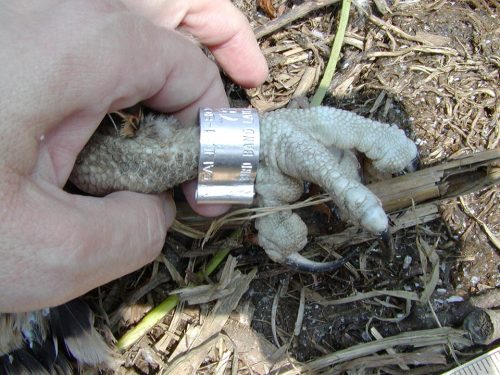
So I wrote back to Ben, pointing out the bird’s age. I know osprey can live up to 20 or 25 years old on the high side. But in general, only 50 percent of birds of prey make it past their first year; it’s a hard-knock life learning to hunt, fly, and, in the osprey’s case, fish.
Ben responded, “The male that nests at our osprey camera at Barnegat Light was 17 this past year as well. For both, it will be really interesting to see if they return since they would be the oldest living osprey observed in New Jersey. The previous record was 17 and held by the male at the Thompson’s Beach nest.” That is near East Point Lighthouse and also a nest where we band and that our CU Maurice River volunteers monitor.
I e-mailed Kim who had caught the lucky snapshots. I asked permission to use her photographs in anticipation of writing this story as a follow-up to my article about knowledge gained from bird banding, titled “Number Please,” in the December 6, 2023 issue of this newspaper. She enthusiastically agreed.
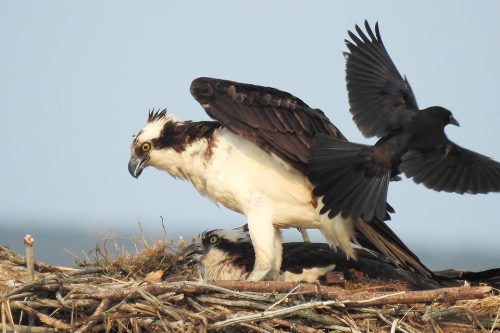
As I reflected on her discovery I thought it would also be interesting to reach out to her and ask her about the sightings and the resulting photos. I expected her to be a typical birder with a big lens who happened to capture a few nice shots. But I guess you could say this is where the middle of this story begins.
Kim hails from Harrisburg, Pennsylvania and traditionally summers at Assateague Island. But this year would be different; she would have to stay close to her camper just outside of Bombay Hook. Longer trips were not possible because in May of 2023 she was in a head-on crash with a drunk driver. For three weeks she experienced pain, which she thought was simply bruising from the safety belt. However when her pain did not abate she discovered her injuries included a broken sternum. So driving around Delaware Bayshore in Delaware had to be shortened and confined to Port Mahon.
She had not planned to spend her 2023 summer weekends photographing ospreys. But as the hours turned into days and months she became consumed by watching and capturing them with her camera from a port access road. This vantage point was just 75 feet from two nesting sites where she could use her car as a blind. She witnessed both females lay and begin incubating their eggs. Then tragedy hit. The pier-based nest and its eggs were washed out by an especially high tide. The nest on a steel beam remained.
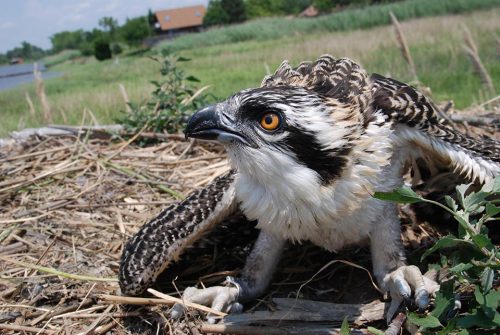
As the days passed she watched the remaining female conclude the 35- to 40-day incubation process. When ospreys begin to incubate it is not rare for them to see the last snows of March and early spring winds and heavy rains.
After incubation comes eight weeks of countless feedings. The summer heat sets in and parents shade their young with their wings. This is followed by the youngsters learning to fly, fledge, and fish.
Kim began the summer embittered by the accident and her limited mobility. But as she reflected on the bird’s being confined by its nesting responsibilities, leaving only to forage, she started to feel her own predicament and complaints were overshadowed by the osprey’s dedication and labors. She witnessed the harsh weather that the bird endured.
Kim described the bird’s dedication as being oddly therapeutic. She became less resentful about the drunken driver, and more empathetic and concerned about the bird’s welfare than her own struggles. The relationship with the bird had become healing, restorative.
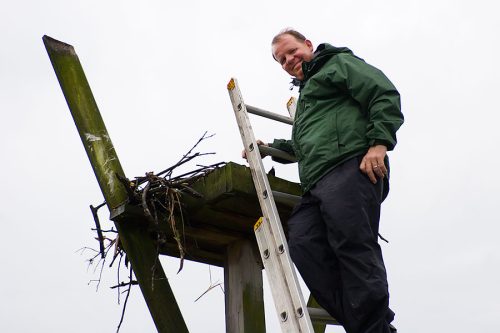
After the one nest was entirely swept away her own losses seemed to pale. A crushed Jeep and not being able to enjoy her usual activities in Assateague were minor in comparison to losing a house and a family. Having witnessed the nest swept away by the tide, Kim lay awake on stormy nights, wondering if her avian family had prevailed in bad weather.
The bird laid two eggs, as is commonly the case. One hatched and the chick ultimately fledged. A family of three osprey requires six pounds of fish each day to feed, so parents must be very diligent fishermen in order to raise their young. Witnessing the labors of adult osprey raising their young is inspiring.
Kim is a cancer survivor of seven years. When she was laid-up, her boyfriend and family bought her a birdfeeder so that she could enjoy watching birds from the confines of her house. It was then that she took up bird photography.
She divulged to me that she was scared of birds, but it was birds who brought her through her illness. I asked if she was still frightened of them and she said she enjoys them from afar. As a young person she saw The Birds, a horror film by Alfred Hitchcock, and it had a lasting effect. Oddly enough over the years I have met a number of people who have a fear of birds, and most attribute it to this film. Yet if a young person were to see the film today, they would probably just laugh at the antiquated and unrealistic special effects.
Ospreys have extreme nest fidelity and if the Port Mahon site remains the same, the pair is likely to try and nest on the same steel beam. We are counting on Kim’s hawk eyes this spring to see if the female returns to raise her next brood. I hope our story will not end, and the middle will continue beyond 17 years.
Nature is powerful and restorative, just ask Kim.
Migratory Math
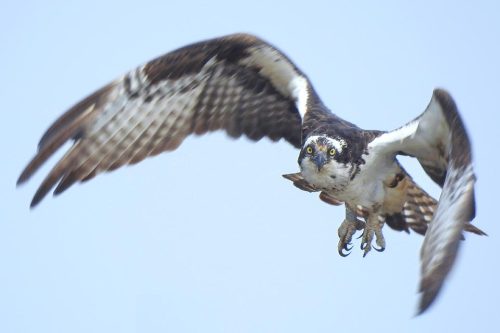
The Port Mahon, New Jersey-born female was 17 years old in the summer of 2023. Two birds have tied with her for longevity as New Jersey’s oldest osprey on record.
If we are to presume that her migration took her to the Amazon Basin each year (like many local osprey), she will have flown a distance of more than four circumnavigations of our planet in migrating south in winter and returning north in spring.
A red knot shorebird known as “Moonbird” is famous for having navigated back and forth repeatedly from the tip of South America to the Arctic for a total distance equal to that from Earth to the moon.
Osprey, Bird of Prey
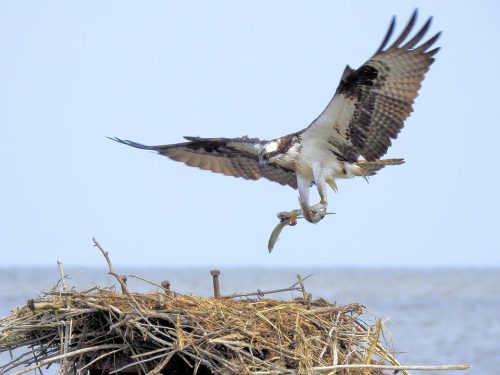
Osprey are birds of prey that are often called fish hawks since their diet consists of 99 percent fish. They exist on every continent except Antarctica. They have large talons and long legs for catching their slippery prey; their reversible outer toe allows them to maneuver the fish in flight, carrying it head first for better aerodynamics. The top of their wings is dark, their head’s crown is white, and a dark stripe goes across their face and eyes. Their chest is white and the color extends to the bend (wrist) in the wing.









